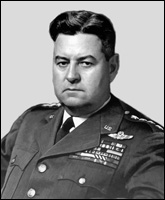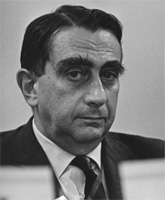IN 1962, THE RUSSIANS HAD NO DEFENSE AGAINST A BRITISH EMPIRE THERMONUCLEAR ATTACK!! THEY DID HAVE A DOOMSDAY DEVICE OR "SAMSON OPTION" THAT WOULD HAVE ENDED ALL LIFE ON EARTH SO THAT THE AGGRESSORS COULD NOT "CELEBRATE THEIR VICTORY!" |
Tsar Alexander I burned Moscow rather than let Napollyon celebrate his "victory." Facing overwhelming odds during the1st Crimean War, they sank their Black Sea fleet and retreated. The "Samson Option" is a brilliant strategy when facing overwhelming odds!
If all went according to plan, doomsday was scheduled to begin on Reformation Day, October 31, 1962. A successful invasion of Cuba was supposed to precede a diabolical false flag operation.
 The globetards view of the rotating football! |
|
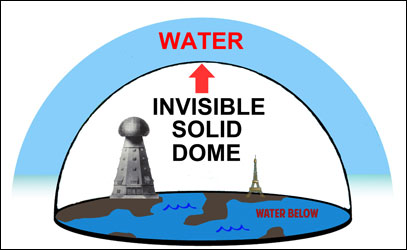 The Biblical view of the earth as a self-contained sealed system! |
An Argentine 14-kiloton Pentagon nuclear warhead, was supposed to be fired at the U.S. mainland.
President Kennedy had already announced on nationwide TV that any nuclear missile launched from Cuba against any nation in the Western Hemisphere required a full retaliatory thermonuclear attack upon the Soviet Union.
A thermonuclear attack on Russia would have ended all life on earth as the Soviets were ready to deploy their "Samson Option" or Doomsday Device.
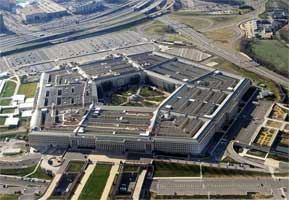 The "peaceful" Pentagon wanted to turn the world into a lifeless desert!! |
|
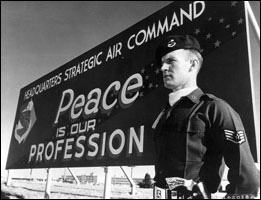 SAC HQ, Omaha, Nebraska. The peace pistol was locked and loaded!! |
On June 30, 1961, General Curtis "Bombs Away" LeMay was appointed Air Force Chief of Staff by President Kennedy. His position at SAC was taken by General Thomas Power.
|
|
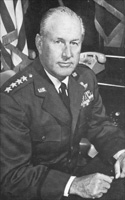 General Thomas Power (1905–1970). |
From a military standpoint, general Curtis LeMay had overwhelming superiority:
There were not only a substantial portion of his (LeMay's) bombers in the air, but SAC and TAC crews were on alert status in ready rooms, their aircraft fueled and loaded with appropriate ordnance, including nuclear weapons. External power supplies were connected to the aircraft. That morning 1,576 U.S. Air Force bombers and 283 missiles stood poised to strike the Soviet Union. (Brugioni, Eyeball to Eyeball, pp. 483-484).
Add to that Churchill's H-bomb (hell bomb) arsenal and it looked like the free world was completely doomed.
General Curtis LeMay was the mad bomber portrayed so graphically by author Peter Bryant in his novel Red Alert.
The doomsday device was the cobalt hydrogen bomb!!
Dr. Leo Szilard is called the "Father of the Atomic Bomb." He conceived the nuclear chain reaction in 1933, patented the idea of a nuclear reactor with Enrico Fermi, and in late 1939 wrote the letter for Albert Einstein's signature that resulted in the Manhattan Project that built the atomic bomb.
Leo Szilard was terrified of the idea that Adolf Hitler would get the atomic bomb first, and that is why he urged President Roosevelt to begin the development of the bomb.
In January 1950, President Truman announced that work on the hydrogen bomb would commence. Dr. Szilard was not invited to work on that fiendish weapon as he knew its destructive potential. Nothing could stop the momentum toward doomsday, but Szilard hoped that a Russian hydrogen bomb could somehow balance the scales of terror.
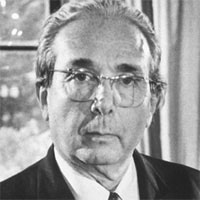 Dr. Leo Szilard (1898–1964). |
|
 The 1950 University of Chicago Round Table Conference. |
Professor Szilard predicted that it would take about 500 tons of heavy hydrogen to kill everybody on earth:
The hydrogen bomb, if developed, could be rigged in such a way as to exterminate the entire world's population or most of it, four leading atomic scientists warned yesterday. This could be done simply by incorporating common substances in the hydrogen bomb, they declared. When detonated, the explosion would release tremendous quantities of neutrons, the most penetrating particles in nature. These, in turn, would enter into the nuclei of the incorporated element and make them intensely radioactive. (New York Times, March 20, 1950).
The 4-man Round Table also predicted that the hydrogen bomb would take about 4 years to develop and Leo Szilard was rarely wrong in his predictions.
Radiation from a primary fission bomb compresses a secondary section containing both fission and fusion fuel. The compressed secondary is heated from within by a second fission explosion. Theoretically, there is no limit to the size of a hydrogen bomb. The Russian Tsar Bomba, exploded in 1961, was 50 megatons.
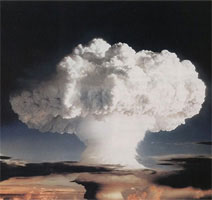 The first hydrogen bomb was called "Ivy Mike." |
|
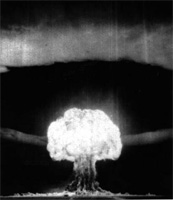 The first Soviet hydrogen bomb was nicknamed "Joe 4." |
Both nations were now in a position to add cobalt hydrogen bombs to their arsenals. Here is a quote from an article in the New York Times of 1954:
The new chemical compound that has revolutionized the production of the hydrogen bomb now makes it certain that the most dreaded weapon of all—the cobalt bomb—also can be successfully built. (New York Times, April 7, 1954).
This new discovery ensured that H-bombs (hell bombs) could be built smaller and smaller.
The Cuban Missile Crisis was predicted by author Peter Bryant!!
Incredible as it may seem, the Cuban Missile Crisis doomsday scenario was predicted in a book named Red Alert. Instead of a rogue commander ordering a SAC attack on Russia, "Soviet nuclear missiles" in Cuba were used as a pretext to launch a thermonuclear first strike.
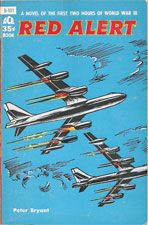 The cover of Red Alert. |
|
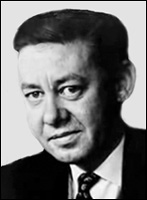 Red Alert author Peter Bryant (1924–1966). |
Red Alert sold over 200,000 copies in the United States. Here is a brief quote about the Doomsday Device:
"Exactly," the President said. "But the rest would die. Gentlemen, we have incontestable proof the Russians have buried at least twenty, maybe more, of these devices in the Urals. It is my belief, based on a lifetime's study of the Russian character in particular, and also the behaviour of dictators facing defeat in general, that if they see they are beaten they will not hesitate to fire those devices. "Have you any doubt Hitler would indeed have brought the world down in flaming ruins if he had had the power to do so when Berlin was under siege? Fortunately, he did not have the power, he could only destroy himself. But notice that he did destroy himself, rather than endure defeat. In every dictatorship which is tottering, there is an urge towards destruction. Of self, if that only is possible. Of the world, if that is. Gentlemen, I am convinced if the eight forty-third wing carry out their mission, and with such success it is obvious to the Russians they have lost, then they will press the button. And if they do, within ten months from now our Earth will be as dead as the Moon. (Red Alert, Chapter 9).
One of the influential men who read the book was the future defense secretary, Robert McNamara. McNamara had just been promoted to president of the Ford Motor Company, at the fantastic salary of over $400,000 yearly.
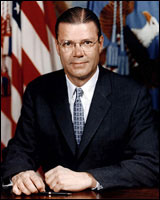 Robert McNamara (1916–2009). |
|
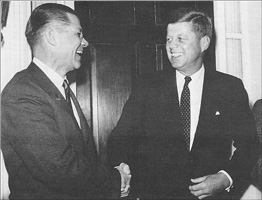 Accepting President-elect Kennedy's offer to be secretary of defense, Dec. 13, 1960. |
The new secretary of defense took a whopping cut in salary to work at the Pentagon and oversee the Joint Chiefs:
To fulfill the wish to be a leader above narrow, monetary interests, McNamara bent over backward regarding his money. He also wanted to be free of any appearance of conflict of interest. At Senate confirmation hearings on January 17, he announced he had designated the Continental Bank of Illinois to hold his liquid assets in blind trust. His yearly income at Ford had been $410,000, which he now gave up for the secretary's government pay of $25,000 per year. He owned 24,500 shares of Ford stock, estimated at $47 per share. He chose voluntarily not to exercise options on an additional 30,000 shares the company owed him on termination, since to sell them would engender a conflict of interest, given that Ford had some defense contracts. The act of forfeiting future wealth was important to him. It was also noted by the Washington press, which glowingly noted his sacrifice as a sign of high-mindedness and excellence among Kennedy's men. (Shapley, Promise and Power, pp. 90-91).
Appointing McNamara as LeMay's boss was the best decision President Kennedy ever made.
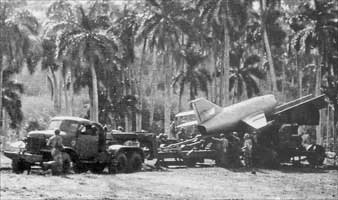 An Argentine cruise missile was fitted with a 14-kiloton nuclear warhead. |
|
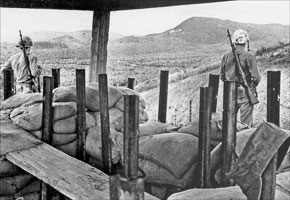 Marines guarding Guantánamo during the Cuban Missile Crisis. |
The Joint Chiefs had an operational plan to strike the Cuban SAM site at least 2 hours after a U-2 shoot-down. McNamara countermanded that order and told LeMay to stand down:
The White House, realizing that there was a standing order for the immediate destruction of a firing SAM site, frantically contacted General LeMay and asked if the strike aircraft had been launched. LeMay replied that they were being briefed and prepared for launch. LeMay was admonished not to launch the aircraft until he received direct orders from the President, Angered, LeMay hung up."He chickened out again. How the hell do you get men to risk their lives when the Sam's are not attacked?" When an aide said he would wait at the phone for the president's order, LeMay disgustedly said, "It will never come!" (Brugioni, Eyeball to Eyeball, pp. 463-464).
In fact it was prime minister Macmillan who "chickened out" when Oleg Penkovsky was arrested on October 26. Without the British bomber command to lead the charge, SAC could not launch an attack on its own.
With no false flag operation to justify Armageddon, LeMay could just boil with rage as his doomsday scenario failed to materialize.
Robert McNamara knew that the men under him at the Pentagon were responsible for the murder of President Kennedy, but he stayed on after the assassination in order to restrain them from initiating another Cuban Missile false flag operation.
Stanley Kubrick made a comedy movie about Armageddon!!
Stanley Kubrick was a movie director who deeply regretted that the apocalypse or doomsday did not begin in October 1962. Kubrick was aware that the Russian doomsday device existed, so he set about to discredit it by using humor or satire.
Kubrick bought the rights to Red Alert for a pittance and then proceeded to turn the book into a comedy. It is a wonder that he never thought about making a comedy movie about the Holohoax.
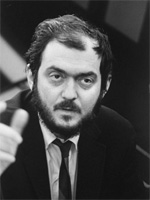 Edomite Stanley Kubrick (1928–1999). |
|
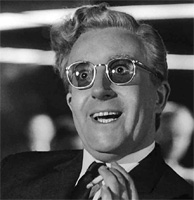 "Dr. Strangelove" was played by actor Peter Sellers. |
After the release of the movie in 1964, a new word entered the English language, STRANGELOVIAN: of or pertaining to nuclear apocalypse, especially through incompetence or shortsightedness.
|
|
|
Another candidate for the character of "Dr. Strangelove" was an Edomite named Lewis Strauss–the chairman of the Atomic Energy Commission. To the great disappointment of those 3 men, a worldwide nuclear holocaust was narrowly avoided.
Vital links
References
Bryant, Peter, Red Alert. Ace Books, Inc., New York, 1958,
Brugioni, Dino A. Eyeball to Eyeball: The Inside Story of the Cuban Missile Crisis. Random House, New York, 1990.
Kahn, Herman. On Thermonuclear War. Princeton University Press, Princeton, NJ, 1960.
Lanouette, William. Genius in the Shadow: A Biography of Leo Szilard, the Man Behind the Bomb. Charles Scribner's Sons, New York, 1992.
Shapley, Deborah, Promise and Power: The Life and Times of Robert McNamara. Little, Brown and Company. Boston, MASS, 1993.
Smith, P.D. Doomsday Men: The Real Dr. Strangelove and the Dream of the Superweapon. St. Martin's Press, New York, 2007.
Copyright © 2020 by Patrick Scrivener
